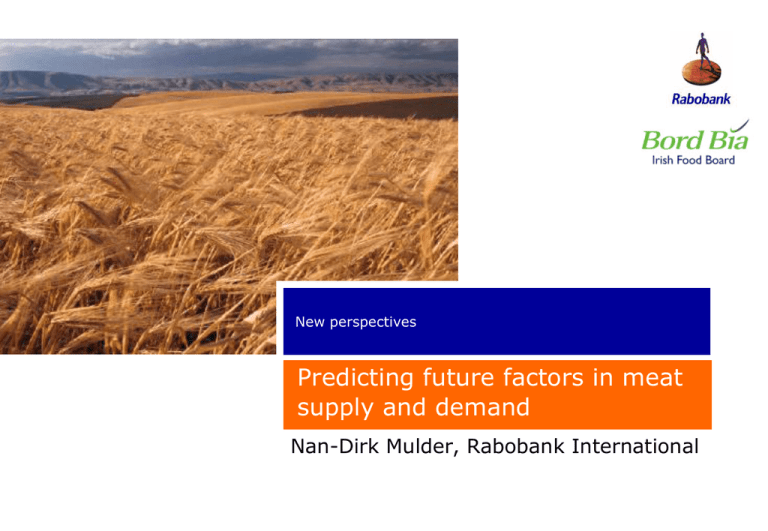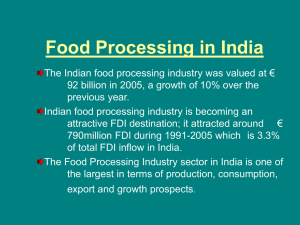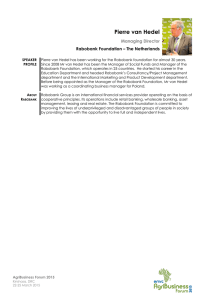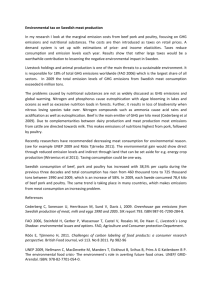Predicting future factors in meat supply and demand Nan-Dirk Mulder, Rabobank International
advertisement

New perspectives Predicting future factors in meat supply and demand Nan-Dirk Mulder, Rabobank International Contents • Section 1: Short term outlook • Section 2: Long term outlook Rabobank International Rabobank: A leading Food & Agribank Presence in 41 countries Rabobank in Ireland Established in August 1994 Subsidiary of Rabobank Nederland Full banking licence and IFSC licence Rabobank Nederland Rabobank Ireland plc Ireland‟s 5th largest bank balance sheet Ireland's 2nd largest non-domestic bank Food & Agri Focus Corporate Banking and Treasury: Corporate and Syndicated Lending Receivables Financing/Leasing Global Financial Markets M&A Structured Commodity Finance Rabobank Ireland Corporate Banking & treasury ACC Bank SME Market De Lage Landen Leasing Eureko Reinsurance How to reach sustainable growth in a much more dynamic industry? 2006Globalisation of industry 2006Commodityprice volatility 2008Exchange-rate volatility 2008Economic crisis Market dynamics and animal diseases Next: -Sustainability -Animal welfare - Volatility -Trade liberalisation vs protectionism Different speed of recovery in 2010 and 2011 -2.5% 3.1% 2.7% Canada US 2,6% 2.3% -2.6% 5.0% 3.9% -6.5% -4.1% EU 1.7% Russia 4.0% 4.3% -7.9% 1.5% China 9.1%10.5% 9.6% -5.2% Japan Sub-Saharan Africa 5.5% 5.0% 2.6% Mexico India 9.7% 8.4% 5.7% 7.5% 4.1% -0.2% Brazil GDP Growth Source: Rabobank based on IMF data, October 2010 6 2.8% World 2009 -0.6% 2010 (f) 4.8% 2011 (f) 4.2% 1.4% Competition for food: what‟s next? Grains and oilseed price development 2000-2010 (USD/ton) 600.0 500.0 400.0 300.0 200.0 100.0 0.0 Wheat Corn Soybean Meal Change in stocks to use in 2010 driving bullish tone for 2011 Change in world ending stocks & stocks/use of key grains and oilseeds Source: Rabobank Bull commodity markets clouded by macro uncertainty Wheat price outlook Corn price outlook Soybean price outlook Recovery in global meat market, but trade restrictions effect global market Global meat demand outlook Global trade outlook 1,000 tonnes 25,000 80,000 22.1 million 21.9 million 22.4 million tonnes tonnes 21.4 million tonnes tonnes +2.6% +2.8% +0.7% 70,000 20,000 1,000 tonnes 60,000 +3.1% +2.5% +4.6% 50,000 -2.2% -0.9% +2.1% +0.9% +0.1% -0.9% 1,000 tonnes -2.3% -0.5% -0.1% 40,000 15,000 +0.4% +2.6% +3.3% 10,000 30,000 20,000 5,000 -2.2% -0.9% +2.1% 10,000 Beef 2005 Broiler 2006 2007 Pork China 2008 Source: USDA, December 2010 2009 Pork Other 2010 2011 2005 2006 Pork 2007 2008 Broiler 2009 2010 Beef 2011 Poultry industry will outperform pork and beef industry in 2010 Global meat production forecast 2010 11.7% +2.4% 0.9% -2.2% 1.9% 0.4% +1.8% -0.1% +0.8% -0.4% Euro Area Canada +1.0% +2.9% 2.6% -3.7%-0.5% Russia -0.2% 3.7% -0.4% -1.4% Japan 2.2% -3.7% Mexico US +3.9% 3.6% 1.3% China +3.6% India 2.4% 5.8% 1.8% 10.0% Brazil Australia 2.2% -23.0% Argentina 11 Source: USDA, October 2010 Production Growth Broiler: +3.3% Pork: +1.0% Beef: -1.2% -2.3% Global trend will continue in 2011 Global meat production forecast 2011 6.7% 2.0% -1.7% -0.8% 0.9% +1.8% -0.6% Canada EU-27 1.5% 2.0% 2.5% 1.8% 1.5%-2.8% Russia Japan 3.0% 3.0% -1.8% US Mexico 0.7% -0.8% -1.4% -2.3% -2.8% 1.9% 2.9% China 2.5% India 2.5% 2.9% 5.8% 1.9% 9.1% Brazil Australia 2.2% -1.9% Argentina 12 Source: USDA, October 2011 Production Growth Broiler: +2.4% Pork: +1.9% Beef: -0.2% -1.4% Contents • Section 1: Short term outlook • Section 2: Long term outlook Rabobank International Key challenge: Global food supply Meat demand Food demand Fuel demand Meat supply Food supply Fuel supply +20% in 10 years Expansion Efficiency Yield Livestock/poultry supply Livestock supply Grains and oilseed supply Land use Efficiency Cultivation Yield ??????? Great challenge for sector: Fast-growing demand for agricultural products Global demand for agriculture (change 2008-18) 220% Grains and oilseeds Sugar Livestock and dairy Biofuel Additional demand: 500 m. tonnes De Grains and oilseeds markets 2008-2018 200% Wheat Coarse grains Rice Oilseeds 180% 160% Market volume growth Growth % + 70 million tonnes 10% + 190 million tonnes 17% + 46 million tonnes 10% + 133 million tonnes 20% Share developing markets 72% 50% 98% 78% 140% 120% Demand for agriculture 2008-18 De 100% 80% Fuel, 130 million tonnes 60% Food, 180 million tonnes 40% 20% 0% Wheat Coarse grains Rice Oilseeds Beef Pigmeat Source: OECD, FAO, Rabobank estimate, 2009/10 Poultry Milk Sugar Ethanol Biodiesel Feed/Animal protein, 190 million tonnes How to produce? How to produce 500 million tonnes? Unused arable land: 180 million hectares South Africa 3% HECTARES U.S. 11% FSU 21% Brazil 54% Food, feed, fuel demand 2020 Additional 140 million EU-27 11% Hectares Yield improvement Food, feed, fuel demand 2010 LOW HIGH YIELD 30% yield increase Grains yield (tonnes/ha) in 2007/2008 Wheat Corn Brazil 2,100 3,800 EU-15/27 4,830 6,480 Russia 2,020 3,790 Ukraine 2,340 4,210 U.S. 2,720 9,660 Source: OECD, 2009 70% of global growth in demand for meat will be in Asia Market growth estimate for key meat markets 2010-2020 25,000 20,000 15,000 10,000 5,000 -5,000 Source: Rabobank, FAO, FAPRI, OECD Poultry Beef Pork Who‟s going to produce world meat demand? Broiler cost of production (USD/kg) Pigs cost of production EUR/kg cwe 1.2 1,80 1,60 1 1,40 0.8 1,62 1,57 1,40 1,61 1,40 1,20 1,04 1,00 0.6 0,91 0,80 0,60 0.4 0,40 0.2 0,20 - 0 US BRA ARG EU RUS CHI THA IND NL DE Source: Rabobank estimate 10% of global production is traded internationally DK ES PL US BR Future meat production growth Global meat production 2009 – 2018 (1,000 tonnes and CAGR 2009-2018) 100,000 90,000 +2.3% 80,000 70,000 60,000 50,000 +1.0% 40,000 +0.5% +3.5% 30,000 20,000 +4.0% 10,000 +2.6% - Source: Rabobank/OECD, 2010 Poultry Pork Beef +1.0% +1.8% +0.3% Water issues will start to bite „Ring of fire‟ region as future spearhead in global trade Rabobank International A fast-changing global meat industry landscape 1,000 tonnes 14,000 Global ranking: Meat companies 12,000 10,000 8,000 6,000 4,000 2,000 - * Including Bertin, Pilgrim's Pride ** Merger Perdigão, Sadia Source: Rabobank estimate based on public sources Poultry Beef Pork The beef industry most consolidated industry on global level Consolidation in the global meat industry 100% 90% 80% 70% 60% 50% 40% 30% 20% +2% 10% 0% 7% 20% 20% 7% Pork Beef Other Source: Rabobank estimate +1% 9% Poultry Pipeline 9% 7% +2% Meat Top 3 market share 7% 7% Feed Brazilian and US companies drive global consolidation process in meat industry Bounce back: dealing with volatility as key successfactor for whole value chain Grains and oilseeds Feed Farming Processing Customer Market intelligence Information exchange = + Volatility in grains and oilseeds Volatility in livestock and poultry markets Market power Request for stable sales prices Hedging/price management Volatility in exchange rates Risk management Corporate social responsibility: Example global warming Tonnes CO2-e per tonne of production Lobbying: Sweden Governments policy • Swedish Beef Approx. 16 - 20 kg CO2e per kg meat • Europ eanBeef Approx. 20 - 27 kg CO2e per kg meat • Brazilian Beef Approx. 38 - 40 kg CO2e per kg meat = Always buy Meat from Europe Retail Price competitiveness and flexibility of poultry fitting well with future market needs CostAnimal of production – comparison “efficiency” protein cost Production cycle, cycle “Flexibility” Duration of farming pangasius +39% Pangasius shrimp +13% Shrimp salmon +12% Salmon poultry +27% pork +41% Beef Euro/kg Pork +16% 0 2 2006 27 Poultry 4 2007 Beef (finishing system) 6 2008E Months 0 juveniles stage 10 20 30 finishing stage 40 A future picture? LOCAL TRADE Fresh perishable products -Fresh meat -Speciality products GLOBAL TRADE Not perishable products - Frozen products - Further processed products … or this? Or is this the future? And beef? Does beef deserve its premium price position? Do we deliver on: - taste - tenderness - juiciness - consistency of the above - consumer friendliness in preparation - social attributes (associated with production, processing) such as animal welfare, environment - product STORY? European sector should better utilise large European market Scandinavia: High incomes EU-27: Almost 500 million consumers Large differences in competitive advantages UK: Added-value market; strong retail NW Europe: One market; consumer concerns Southern Europe: Traditional demand, growing market Poland: 40 million consumers; costprice advantages Romania: 22 million consumers; labour costs EUR 200/month Poultry industry still a domestic ihdustry The European industry moves from national to regional and from regional to pan-European Northwest - 173 million consumers North- 20 million consumers South- 171 million consumers South East - 41 million consumers East - 79 million consumers Export/Import Irish food & agrisector: livestock sector drives industry growth Sheep Production growth (00/07) How to compete in the current competitive industry landscape? VOLUME VALUE Efficiency Branding”Ireland” Scale Internationalisation Pasture based Future Irish food industry Free range/organic Sustainability Value Chain Premium products Sustainability Risk management Conclusions Great long-term meat demand potential for global industry with growing emphasis on yield throughout the value chain Dealing with volatility in feed ingredients and exchange rates will be a key challenge for the industry in the coming years Waves of protectionism and diseases put significant impact on markets and industries Growing importance of consumer concerns in industry. Industry should participate in global discussions and come with innovative ideas Consolidation in the global industry is driven by Brazilian and US companies; Europe is fragmented and does not utilise opportunities in large EU market Global feed to meat industry landscape will change significantly in the next 10 years – Companies from emerging markets (China, Brazil) will play a leading role Irish industry needs to restructure to meet fast changing industry dynamics New perspectives Thanks for your attention Nan-Dirk Mulder Rabobank International Nan-Dirk.Mulder@rabobank.com





